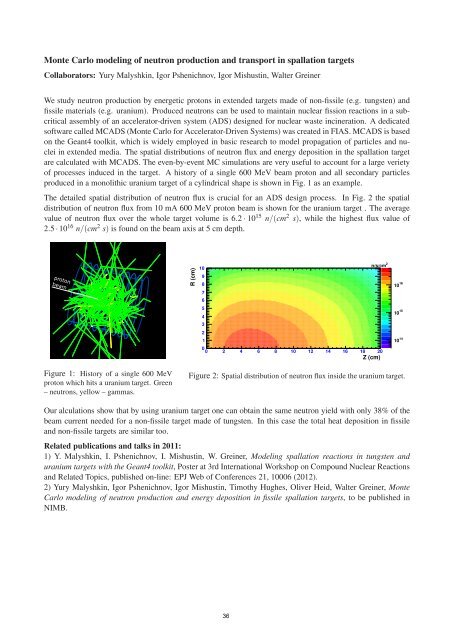FIAS Scientific Report 2011 - Frankfurt Institute for Advanced Studies ...
FIAS Scientific Report 2011 - Frankfurt Institute for Advanced Studies ...
FIAS Scientific Report 2011 - Frankfurt Institute for Advanced Studies ...
Create successful ePaper yourself
Turn your PDF publications into a flip-book with our unique Google optimized e-Paper software.
Monte Carlo modeling of neutron production and transport in spallation targets<br />
Collaborators: Yury Malyshkin, Igor Pshenichnov, Igor Mishustin, Walter Greiner<br />
We study neutron production by energetic protons in extended targets made of non-fissile (e.g. tungsten) and<br />
fissile materials (e.g. uranium). Produced neutrons can be used to maintain nuclear fission reactions in a subcritical<br />
assembly of an accelerator-driven system (ADS) designed <strong>for</strong> nuclear waste incineration. A dedicated<br />
software called MCADS (Monte Carlo <strong>for</strong> Accelerator-Driven Systems) was created in <strong>FIAS</strong>. MCADS is based<br />
on the Geant4 toolkit, which is widely employed in basic research to model propagation of particles and nuclei<br />
in extended media. The spatial distributions of neutron flux and energy deposition in the spallation target<br />
are calculated with MCADS. The even-by-event MC simulations are very useful to account <strong>for</strong> a large veriety<br />
of processes induced in the target. A history of a single 600 MeV beam proton and all secondary particles<br />
produced in a monolithic uranium target of a cylindrical shape is shown in Fig. 1 as an example.<br />
The detailed spatial distribution of neutron flux is crucial <strong>for</strong> an ADS design process. In Fig. 2 the spatial<br />
distribution of neutron flux from 10 mA 600 MeV proton beam is shown <strong>for</strong> the uranium target . The average<br />
value of neutron flux over the whole target volume is 6.2 · 10 15 n/(cm 2 s), while the highest flux value of<br />
2.5 · 10 16 n/(cm 2 s) is found on the beam axis at 5 cm depth.<br />
proton<br />
beam<br />
Figure 1: History of a single 600 MeV<br />
proton which hits a uranium target. Green<br />
– neutrons, yellow – gammas.<br />
R (cm)<br />
10<br />
9<br />
8<br />
7<br />
6<br />
5<br />
4<br />
3<br />
2<br />
1<br />
2<br />
n/s/cm<br />
0<br />
0 2 4 6 8 10 12 14 16 18 20<br />
Z (cm)<br />
Figure 2: Spatial distribution of neutron flux inside the uranium target.<br />
Our alculations show that by using uranium target one can obtain the same neutron yield with only 38% of the<br />
beam current needed <strong>for</strong> a non-fissile target made of tungsten. In this case the total heat deposition in fissile<br />
and non-fissile targets are similar too.<br />
Related publications and talks in <strong>2011</strong>:<br />
1) Y. Malyshkin, I. Pshenichnov, I. Mishustin, W. Greiner, Modeling spallation reactions in tungsten and<br />
uranium targets with the Geant4 toolkit, Poster at 3rd International Workshop on Compound Nuclear Reactions<br />
and Related Topics, published on-line: EPJ Web of Conferences 21, 10006 (2012).<br />
2) Yury Malyshkin, Igor Pshenichnov, Igor Mishustin, Timothy Hughes, Oliver Heid, Walter Greiner, Monte<br />
Carlo modeling of neutron production and energy deposition in fissile spallation targets, to be published in<br />
NIMB.<br />
36<br />
16<br />
10<br />
15<br />
10<br />
14<br />
10
















